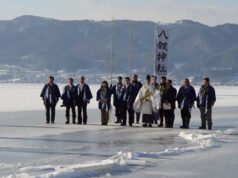Kishan Ganga River Kaleidoscopic reflection of Kashmir’s ethos

By
Col Satish Singh Lalotra
‘There are many ways to salvation, one of them is to follow a river”…
David Brower……
American enviornmentalist.
From times of yore, we humans have grown up to the oft repeated statement that Great civilizations were born on the banks of mighty rivers, be it Indus valley, Egyptian or Mesopotamian. Indus, Nile and Euphrates the mighty rivers were the life blood of these civilizations respectively leaving an imprint for posterity. The quote above on rivers sums up the intricate relationship which a man has with it, wherein the survival of both is defined by a symbiotic association, both drawing sustenance from each other. India the land of abundance has been blessed with a plethora of natural resources, the likes of which are seldom found anywhere on this planet. From perennial Himalayan rivers to towering mountains, it may take an average Indian more than a life time to explore his own backyard. The Union Territory of J&K in particular has been picked up by the Almighty to shower his choicest of blessings in the form of great Himalayas/Karakorum ranges and river such as Jhelum, Chenab, Indus and the most unforgettable of all the mighty Kishan Ganga to name a few.
Having heard of Kishan Ganga river many times before, I never had the opportunity to view its physical expanse and the wonderful legacy of history, art and culture with which its meandering path weaved on its surrounding valleys of Gurez, Tillel in India and Neelum valley in Pakistan. This unique opportunity was provided to me in March 2003, when I first crossed Razdan pass at 11672 feet aboard an IAF MI17 helicopter and alighted at Badoab helipad in Tilel valley/Gurez on getting posted to that area while serving in army. To those who are uninitiated in that area of J&K, let me put it this way that Kishan Ganga river is the northernmost river of the union territory and a symbol of unique blend of Hindu, Muslim and Buddhist bonhomie, in that it flows by famous Buddhist site of Kanzalwan where the last congregation of Buddhist intellectuals was supposed to be held as also touches Dawar the mainstay of Gurez valley which has the world famous Habba Khatoon pyramidical mountain named after famous Muslim Kashmiri female singer Habba Khatoon. The river further leads to the world famous Hindu pilgrim site in Neelum valley in POK i. e the famous Sharda peeth. The Kishan Ganga river originates from the Indian part of Kashmir from lake Krishansar in the vicinity of Sonamarg and runs northwards to Badoab village in Tilel valley/Gurez where it meets a tributary from the Dras side.
It was at Badoab that I spent one and half years of my tenure while serving in the army and dug into the entire history of River Kishan Ganga and its profound effect on the socio-religious discourse of locals. The river meanders its way from Badoab in Tilel valley and runs westwards parallel to the LC/Line of control where its fed from many glacial streams on the way. At Kanzalwan the river enters POK in the Gurez sector, and is named as Neelum river. From here on the river runs /flows west again parallel to the LC passing by Sharada. After Sharada, Neelum river /Kishan Ganga bends to a south westerly direction along the LC near Tithwal. From Tithwal the river bends in a northwesterly direction towards Jhelum river and eventually joins it in Muzaffarabad. The total length of the river from its origin in Indian part of Kashmir till its point of confluence is 245 kms, with 50 kms of its stretch in Indian part and 195 kms in the POK. The people living all along river Kishan Ganga /Neelum river are called as Dards and speak Shina language.
Prior to partition in 1947 river Kishan Ganga and its surrounding Gurez valley had been a popular foreign tourist destination, with the likes of Ex US President Franklin D Roosevelt and his wife visiting the area sometime before becoming the president. During the colonial times river Kishan Ganga and its surroundings were the official ‘Shikargah”/Hunting ground of Maharaja Hari Singh, who along with his few trusted friends used to camp here for their yearly sojourn with “Trout fishing”. Later on late PM Nehru with his daughter Indira Gandhi along with Sheikh Abdullah visited these areas in the 1940s for Trout fishing in Naranag one of the lakes in the mountains above the Kishan Ganga valley. As mentioned above, since great civilizations progressed along and drew sustenance from prominent river systems, Kishan Ganga too was not an exception to this phenomenon and gave rise to one of the holiest Hindu shrines i. e the Sharda peeth along its shores. Sharda peeth now situated in POK is a ruined Hindu temple university and an ancient seat of learning in the days of yore, considered as the abode of lord Shiva.
Between the 6th century and 12th century CE, it was one of the most revered temple universities of India famed for its library, for which scholars from all around the world used to trudge thousands of kilometers to partake in the store house of knowledge. It played a key role in the role and development of ” Sharda script”in north India causing the script to be named after it and Kashmir to acquire the Monicker “Sharda Desh” meaning country of Sharda. Considered as one of the Maha Shakti peeths, Hindus believe that it represents the spiritual location of Goddess Sati’s fallen right hand. Considered as one of the holiest sites by Kashmiri pandits, Sharda peeth is appx 150 kms from Muzaffrabad the capital of POK, 130 kms from Srinagar and 10 kms from the LOC. It is situated at an altitude of 6449 feet above MSL. Interestingly Sharda peeth has a very unique connection with Buddhism in that around 4 th Century CE Buddhist scholars such as Kumarajiva, Thanmi Sabbhota and Rinchen Zangpo were associated with this peeth.
Reverence of Sharda peeth is extended to non Hindus too, when in 16 th century Abul Fazal the grand Wazir of Akbar described the peeth as a stone temple which began to shake on every 8 th tithi of bright half of the full moon, producing extra ordinary effects on the piligrims. In the Indian part of Kashmir the river Kishan Ganga flows by a famous Buddhist site, Kanzalwan from where it takes a detour to POK and is known as Neelum river. Archaeological surveys in the north of Kanzalwan have reported hundreds of carved inscriptions in “Kharoshthi, Bramhi and Tibetan. The carvings provide an insight into the origins of the Kashmiri people and the early history of Buddhism. Walter Lawrence the famous writer in his book “The valley of Kashmir”says Kishan Ganga river valley is perhaps the most beautiful place in entire J&K and eclipses Pahalgam valley totally. Kishan Ganga river is also witness to another historical legend in the form of “Habba Khatoon” peak a formidable mountain in a pyramidal shape named after the famous Kashmiri muslim poetess Habba Khatoon also known as the “Nightingale of Kashmir”. She was the wife of last ruler of king of Kashmir Yusuf Shah Chak who was imprisoned by his rival Akbar Khan. She used to wander around near the peak named after her in search of her husband.
River Kishan Ganga has proved to be a boon off late to the locals of Gurez valley, since India started constructing the famous Kishan Ganga hydroelectric power plant. With a height of 37mts/121 ft the concrete face rock fill dam has a capacity of 1. 8 crore meter cube of water with an installed capacity of 330 MWs and an annual generation of 1713 million KWh of electricity. The dam will solve the long pending demands of electricity of Gurez valley which hitherto were dependent upon diesel generator sets only. Kishan Ganga river’s potential has been harnessed by Pakistan too wherein they have also dammed the water of Neelum river to power a plant on the Jhelum river. Located about 42 kms south of Muzaffrabad, the Neelum-Jehlum hydro power has an established capacity of 969 MWs, but is producing 1040 MWs, which is beyond its capacity a rare precedence in hydel power sector.
The blessed waters of river Kishan Ganga has in fact showered its bounties on the local populace with lot more which has benefitted them for ages. The areas around Kishan Ganga river have not been much ethno-botanical or given to floristic explorations, but it abounds with traditional medicinal plants. The local Dard population don’t believe in allopathic medicines and rely more on the Herbal wealth which abounds the area. The elders of the family generally aware of these herbs and its uses act as De facto family doctors for their near and dear ones. Some of these herbs and plant species discovered by our scientists in the area are Asteraceae/used for treating cold, fever, and liver complaints, Ranunculaceae/used for intestinal parasitic worms, Solanaceae/used as sedative, diuretic and analgesic. Fisheries is another area of economic activity in and around Kishan Ganga river which has great economic potential which must be tapped to ensure a good commercial fish production.
‘Trout farming’ is one of the oldest forms of fish production and can give boost to the local economy in the area which lacks industrial back up. Kishan Ganga river is famous for its cold water Trout fish with an average weight of 24 pounds. Some of the famous Trout fish variety found in this river are Snow Trout/ Schizothorax, it is found in Tilel valley, where I was posted for about one and half years while serving in the army. Brown Trout /Selmo Trutta Fario, Rainbow Trout, Shuddguru, Anyour are some of the other varieties of Trouts found in abundance in Kishan Ganga river waiting to be harnessed by the locals. Though J&K union territory has numerous plans on the drawing board, not many have seen the light of the day as for their fructification. When serving in the army in Badoab/Tilel valley in 2003/04 I happened to visit one of the branches of Fishery department co-located with my unit and met the Dy Director of the department, enquiring as to why despite abundance of Trout fishes in Kishan Ganga river not much was seen on ground in terms of commercial exploitation i. e Trout farms.
As per the official most of the Trouts available in Kishan Ganga river were suffering from eye and fungal diseases. Moreover as per him the world over, stocking of fishes was being done which unfortunately was not the norm over here in Gurez valley for as long as he remembers. But the same was being done in other parts of Kashmir.
As for tourism, Kishan Ganga river and its adjoining areas afford lot of tourism potential to a tourist who has no qualms in exploring the area come what may and is spoilt for choices. Ranging from photography, angling/fishing to hiking on select mountain trails a tourist can have a variety to choose from. Not to forget a visit to Habba Khatoon mountain side, the small villages of Chakwali, Malangam etc to have a look/see of the culture of local Dard population one can fully satiate his/her tourist impulse to one’s full contentment. Despite lot of improvements done by the GOI/Union territory of J&K, there is still room for improvement, and the dire need of the hour is to revive the old glory of river Kishan Ganga upon whose banks history has been etched from times immorial.




